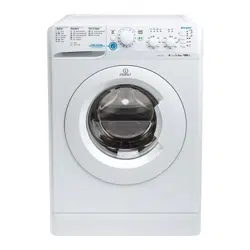Documents: Go to download!
User Manual
- User Manual - (English)
- Dimension Guide - (English)
- Care and maintenance
- Precautions and tips
- Description of the washing machine and starting a wash cycle
- Wash cycles
- Detergents and laundry
- Troubleshooting
Table of contents
User Manual washing machine
Care and maintenance
Cutting off the water and electricity supplies
• Turn off the water tap after every wash cycle. This will limit wear on the hydraulic system inside the washing machine and help to prevent leaks.
• Unplug the washing machine when cleaning it and during all maintenance work.
Cleaning the washing machine
• The outer parts and rubber components of the appliance can be cleaned using a soft cloth soaked in lukewarm soapy water. Do not use solvents or abrasives.
• The washing machine has a “Auto Clean” programme for its internal parts that must be run with no load in the drum. For maximum performance you may want to use either the detergent (i.e. a quantity 10% the quantity specified for lightly-soiled garments) or special additives to clean the washing machine. We recommend running a cleaning programme every 40 wash cycles. To start the programme press buttons A and B simultaneously for 5 seconds (see figure). The programme will start automatically and will last approximately 70 minutes. To stop the cycle press the START/PAUSE button.
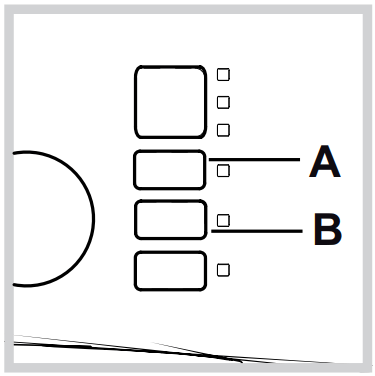
Cleaning the detergent dispenser drawer
To remove the drawer, press lever (1) and pull the drawer outwards (2) (see figure). Wash it under running water; this procedure should be repeated frequently.
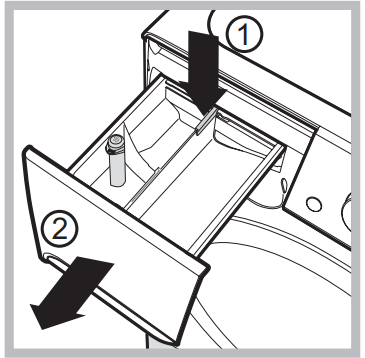
Caring for the door and drum of your appliance
• Always leave the porthole door ajar in order to prevent unpleasant odours from forming.
Cleaning the pump
The washing machine is fitted with a selfcleaning pump which does not require any maintenance. Sometimes, small items (such as coins or buttons) may fall into the protective pre-chamber at the base of the pump.
! Make sure the wash cycle has finished and unplug the appliance.
To access the pre-chamber:
1. Take off the cover panel on the front of the machine by first pressing it in the center and then pushing downwards on both sides until you can remove it (see figures).
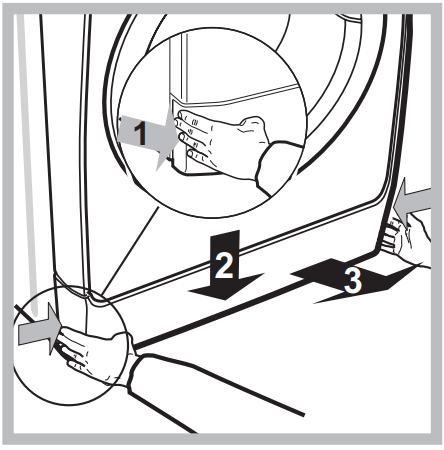
2. Unscrew the lid by rotating it anticlockwise (see figure): a little water may trickle out. This is perfectly normal.

3.Clean the inside thoroughly.
4.Screw the lid back on.
5.Reposition the panel, making sure the hooks are securely in place before you push it onto the appliance.
Checking the water inlet hose
Check the inlet hose at least once a year. If there are any cracks, it should be replaced immediately: during the wash cycles, water pressure is very strong and a cracked hose could easily split open.
Precautions and tips
General safety
• This appliance was designed for domestic use only.
• This appliance can be used by children aged from 8 years and above and persons with re- duced physical, sensory or mental capabilities or lack of experience and knowledge if they have been given supervision or instruction concerning use of the appliance in a safe way and understand the hazards involved. Children shall not play with the appliance. Cleaning and user maintenance shall not be made by children without supervision.
• The washing machine must only be used by adults, in accordance with the instructions provided in this manual.
• Do not touch the machine when barefoot or with wet or damp hands or feet.
• Do not pull on the power supply cable when unplugging the appliance from the electricity socket. Hold the plug and pull.
• Do not open the detergent dispenser drawer while the machine is in operation.
• Do not touch the drained water as it may reach extremely high temperatures.
• Never force the porthole door. This could damage the safety lock mechanism designed to prevent accidental opening.
• If the appliance breaks down, do not under any circumstances access the internal mechanisms in an attempt to repair it yourself.
• Always keep children well away from the appliance while it is operating.
• The door can become quite hot during the wash cycle.
• If the appliance has to be moved, work in a group of two or three people and handle it with the utmost care. Never try to do this alone, because the appliance is very heavy.
• Before loading laundry into the washing machine, make sure the drum is empty.
Load balancing system
Before every spin cycle, to avoid excessive vibrations and to distribute the load in a uniform manner, the drum rotates continuously at a speed which is slightly greater than the washing rotation speed. If, after several attempts, the load is not balanced correctly, the machine spins at a reduced spin speed. If the load is excessively unbalanced, the washing machine performs the distribution process instead of spinning. To encourage improved load distribution and balance, we recommend small and large garments are mixed in the load
Disposal
• Disposing of the packaging materials: observe local regulations so that the packaging may be re-used.
• The European Directive 2012/19/EU on Waste Electrical and Electronic Equipment, requires that old household electrical appliances must not be disposed of in the normal unsorted municipal waste stream. Old appliances must be collected separately in order to optimise the recovery and recycling of the materials they contain and reduce the impact on human health and the environment. The crossed out “wheeled bin” symbol on the product reminds you of your obligation, that when you dispose of the appliance it must be separately collected. Consumers should contact their local authority or retailer for information concerning the correct disposal of their old appliance.
Description of the washing machine and starting a wash cycle
Control panel

Detergent dispenser drawer: used to dispense detergents and washing additives (see “Detergents and laundry”).
ON/OFF button: switches the washing machine on and off. PUSH & WASH button: (see “Wash cycles”).
WASH CYCLE knob: programmes the wash cycles. During the wash cycle, the knob does not move.
FUNCTION buttons with indicator light: used to select the available functions. The indicator light corresponding to the selected function will remain lit.
TEMPERATURE knob and indicator light: sets the temperature or the cold wash cycle (see “Personalisation”).
SPIN SPEED knob and indicator light: sets the spin speed or exclude the spin cycle completely (see “Personalisation”).
WASH CYCLE PROGRESS indicator lights: used to monitor the progress of the wash cycle. The illuminated indicator light shows which phase is in progress.
DOOR LOCKED indicator light: indicates whether the door may be opened or not (see next page).
START/PAUSE button with indicator light: starts or temporarily interrupts the wash cycles. N.B. To pause the wash cycle in progress, press this button; the corresponding indicator light will flash orange, while the indicator light for the current wash cycle phase will remain lit in a fixed manner. If the DOOR LOCKED indicator light is switched off, the door may be opened (wait approximately 3 minutes). To start the wash cycle from the point at which it was interrupted, press this button again.
indicator light is switched off, the door may be opened (wait approximately 3 minutes). To start the wash cycle from the point at which it was interrupted, press this button again.
Standby mode
This washing machine, in compliance with new energy saving regulations, is fitted with an automatic standby system which is enabled after about 30 minutes if no activity is detected. Press the ON-OFF button briefly and wait for the machine to start up again.
Indicator lights
The indicator lights provide important information. This is what they can tell you:
Wash cycle phase indicator lights
Once the desired wash cycle has been selected and has begun, the indicator lights switch on one by one to indicate which phase of the cycle is currently in progress.
Wash 
Rinse 
Spin 
Drain 
End of wash cycle 
Function buttons and corresponding indicator lights
When a function is selected, the corresponding indicator light will illuminate. If the selected function is not compatible with the programmed wash cycle, the corresponding indicator light will flash and the function will not be activated. If the selected option is not compatible with another previously selected option, the indicator light will flash accompanied by a buzzer (3 beeps), and only the latter option will be activated; the indicator light corresponding to the activated option will turn on
 Door locked indicator light
Door locked indicator light
When the indicator light is on, the porthole door is locked to prevent it from being opened; make sure the indicator light is off before opening the door (wait approximately 3 minutes). To open the door during a running wash cycle, press the START/PAUSE button; the door may be opened once the DOOR LOCKED indicator light turns off.
Starting a wash cycle
Rapid programming
1. LOAD THE LAUNDRY.
Open the porthole door. Load the laundry, making sure you do not exceed the maximum load value indicated in the table of programmes and wash cycles on the following page.
2. ADD THE DETERGENT.
Pull out the detergent dispenser drawer and pour the detergent into the relevant compartments as described in “Detergents and laundry”.
3. CLOSE THE DOOR.
4. Press the “PUSH & WASH” button to start the wash programme.
Traditional programming
1. Turn the washing machine on by pressing the ON/OFF button. All the indicator lights will turn on for a few seconds, then only the indicator lights relative to the selected programme settings will remain lit and the START/PAUSE indicator light will flash.
2. Load the laundry and close the door.
3. Set the WASH CYCLE knob to the desired programme.
4. Set the washing temperature (see “Personalisation”).
5. Set the spin speed (see “Personalisation”).
6. Measure out the detergent and washing additives (see “Detergents and laundry”).
7. Select the desired functions.
8. Start the wash cycle by pressing the START/PAUSE button and the corresponding indicator light will remain lit in a fixed manner in green. To cancel the set wash cycle, pause the machine by pressing the START/PAUSE button and select a new cycle.
9. At the end of the wash cycle the END indicator light will switch on. The door can be opened once the DOOR LOCK  indicator light turns off (wait approximately 3 minutes). Take out your laundry and leave the appliance door ajar to make sure the drum dries completely. Switch the washing machine off by pressing the ON/OFF button.
indicator light turns off (wait approximately 3 minutes). Take out your laundry and leave the appliance door ajar to make sure the drum dries completely. Switch the washing machine off by pressing the ON/OFF button.
Wash cycles
Push & Wash
This function allows for starting a wash cycle even when the machine is switched off without having to press the ON/OFF button in advance, or after switching on the machine, without having activated any button and/or selector (otherwise, the Push & Wash function will be deactivated). To start the Push & Wash cycle press and hold the relative button for 2 seconds. The lit indicator light indicates that the cycle has started. This wash cycle is ideal for cotton or synthetic fabrics, as it washes at a temperature of 30° and a maximum spin speed of 1200 rpm. Maximum load 3 kg. (Cycle duration 50’).
How does it work?
1. Load the laundry (cotton and/or synthetic garments) and close the door.
2. Pour the detergent and additives.
3. Start the programme by pressing and holding the Push & Wash button for 2 seconds. The relative indicator light turns green and the door will lock (the DOOR LOCKED symbol turns on). N.B.: starting the wash cycle through the Push & Wash button activates an automatic non-customisable cycle recommended for cotton and synthetic fabrics. This programme does not allow for setting any additional options. To open the door while an automatic cycle is under way, press the START/PAUSE button; if the DOOR LOCKED symbol is switched off the door may be opened. Press the START/PAUSE button again to restart the wash cycle from the point at which it was interrupted.
4. Once the programme is finished, the END indicator light turns on.
Table of wash cycles


* If you select programme and exclude the spin cycle, the machine will drain only.
The length of cycle shown on the display or in this booklet is an estimation only and is calculated assuming standard working conditions. The actual duration can vary according to factors such as water temperature and pressure, the amount of detergent used, the amount and type of load inserted, load balancing and any wash options selected.
1) Test wash cycle in compliance with directive 1061/2010: set wash cycle 8 with a temperature of 60°C. This cycle is designed for cotton loads with a normal soil level and is the most efficient in terms of both electricity and water consumption; it should be used for garments which can be washed at 60°C. The actual washing temperature may differ from the indicated value.
2) Test wash cycle in compliance with directive 1061/2010: set wash cycle 9 with a temperature of 40°C. This cycle is designed for cotton loads with a normal soil level and is the most efficient in terms of both electricity and water consumption; it should be used for garments which can be washed at 40°C. The actual washing temperature may differ from the indicated value.
For all Test Institutes:
2) Long wash cycle for cottons: set wash cycle 9 with a temperature of 40°C.
3) Synthetic program along: set wash cycle 10 with a temperature of 40°C.
Detergents and laundry
Detergent dispenser drawer
Successful washing results also depend on the correct dose of detergent: adding too much detergent will not necessarily result in a more efficient wash, and may in fact cause build up on the inside of your appliance and contribute to environmental pollution.
! Do not use hand washing detergents because these create too much foam. ! Use powder detergent for white cotton garments, for prewashing, and for washing at temperatures over 60°C. ! Follow the instructions given on the detergent packaging. Open the detergent dispenser drawer and pour in the detergent or washing additive, as follows.
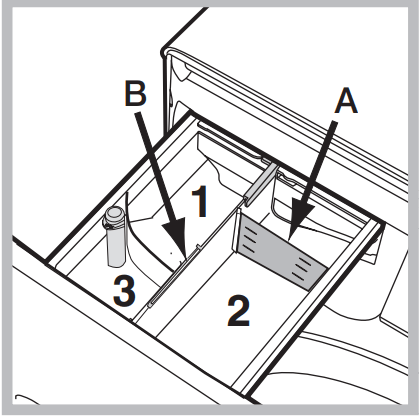
! Do not pour detergent into the compartment 1. Detergent should only be poured into the compartment 2.
Compartment 2: Washing detergent (powder or liquid)
If liquid detergent is used, it is recommended that the removable plastic partition A (supplied) be used for proper dosage. If powder detergent is used, place the partition into slot B.
Compartment 3: Additives (fabric softeners, etc.)
The fabric softener must not exceed the “max” level indicated on the central pin.
Preparing the laundry
• Divide the laundry according to: - the type of fabric/the symbol on the label - the colours: separate coloured garments from whites.
• Empty all garment pockets and check the buttons.
• Do not exceed the values listed in the “Table of wash cycles”, which refer to the weight of the laundry when dry.
How much does your laundry weigh?
1 sheet 400-500 g 1 pillow case 150-200 g
1 tablecloth 400-500 g 1 bathrobe 900-1.200 g
1 towel 150-250 g
Garments requiring special care
Sport (programme 1) is designed for washing lightly soiled sports clothing (tracksuits, shorts, etc.); for best results, we recommend not exceeding the maximum load indicated in the “Table of wash cycles”. We recommend using liquid detergent, and adding the amount suitable for a half-load.
Dark: use cycle 2 to wash dark-coloured garments. This programme is designed to maintain dark colours over time. We recommend using a liquid detergent for the best results when washing dark-coloured garments.
Anti-odour: use programme 3 for washing garments with bad odours (e.g. smoke, sweat, fried food). The programme is designed to remove bad odours while preserving the fabric fibres. Synthetics fabrics or mixed loads should be washed at 40°, and resistant cotton fabrics at 60°.
Delicate: use programme 4 to wash very delicate garments. It is advisable to turn the garments inside out before washing them. For best results, use liquid detergent on delicate garments. For washing Silk items and Curtains, select the relevant cycle and activate the option (in this case it will also be possible to enable the “Extra Rinse” option); the machine will end the cycle with the laundry soaked and the indicator light will flash. To drain the water so that the laundry can be removed, press the START/ PAUSE button to the option
(in this case it will also be possible to enable the “Extra Rinse” option); the machine will end the cycle with the laundry soaked and the indicator light will flash. To drain the water so that the laundry can be removed, press the START/ PAUSE button to the option
Wool: the wool wash cycle of this machine has been tested and approved by The Woolmark Company for the washing of wool containing garments labelled as “hand wash” provided that the garments are washed according to the instructions on the garment label and those issued by the manufacturer of this washing machine. (M1128)
Duvet: to wash single duvets (the weight of which should not exceed 1 kg), cushions or clothes padded with goose down such as puffa jackets, use the special wash cycle number 6. We recommend that duvets are placed in the drum with their edges folded inwards (see figure) and that no more than ¾ of the total volume of the drum is used. To achieve the best results, we recommend that a liquid detergent is used and placed inside the detergent dispenser drawer.
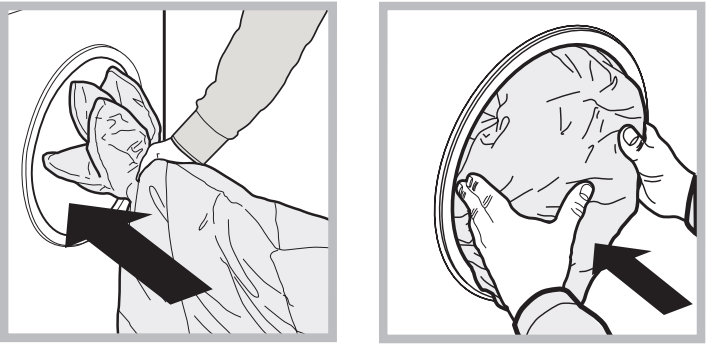
Coloured: use this cycle 11 to wash bright coloured clothes. The programme is designed to maintain bright colours over time.
Cotton Standard 20° (programme 12) ideal for lightly soiled cotton loads. The effective performance levels achieved at cold temperatures, which are comparable to washing at 40°, are guaranteed by a mechanical action which operates at varying speed, with repeated and frequent peaks.
20’ Refresh 20° (programme 13) ideal for refreshing and washing lightly soiled garments in a few minutes. It lasts just 20 minutes and therefore saves both time and energy. It can be used to wash different types of fabrics together (except for wool and silk), with a maximum load of 1.5 kg.
60’ Cotton (programme 14) is designed to wash moderately soiled resistant cotton garments at 60° in an hour, with good washing performance. For synthetic or mixed garments, we recommend lowering the temperature down to 40°.
Troubleshooting
Problem: | Possible causes / Solutions: |
| The machine does not switch on | • The appliance is not plugged into the socket fully, or not enough to make contact. • There is no power to the socket, or the fuse has blown in the mains plug. |
| The wash cycle does not start. | • The door is not closed properly. • The ON/OFF button has not been pressed. • The START/PAUSE button has not been pressed. • The water tap has not been turned on to allow water to flow into the machine. • A delayed start has been set. |
| The machine does not fill with water or the indicator light for the first wash cycle stage flashes rapidly | • The water inlet hose is kinked. • The water inlet hose is not connected to the water supply. • The water pressure is too low. • The water tap has not been turned on to allow water to flow into the machine. • There is no water supply to the house. • The inlet valve filter is blocked. • The START/PAUSE button has not been pressed. |
| The machine continuously fills with water and continually drains away or Water left in the drum or Stuck on wash. | • The top of the drain hose is too low - It must be fitted at a height between 65 and 100 cm from the floor (see “Installation”). • The drain hose is connected incorrectly to the sink trap allowing water to run into the machine, the drain hose must be positioned higher than the bottom of the sink to prevent water flowing down the drain hose. • The end of the drain hose has been pushed too far down the standpipe, the ‘U’ bracket should be fitted 100 mm from the end of the drain hose. |
| The machine does not drain or spin - ( error lights flashing ). | • The Pump filter is blocked. • The drain hose is kinked (see “Installation”). • New Installation - The blanking cap or spigot has not been removed if connected under a sink. • The drain hose or sink trap is blocked. |
| The machine does spin | The Spin Speed is set to . . |
| The machine does not heat or poor wash results. | The Temperature is set to |
The machine does not drain or spin -  ‘START/PAUSE’ indicator lights flash. ‘START/PAUSE’ indicator lights flash. | If the  option is enabled, at the end of the program the machine drum will rotate slowly. To complete the program press the ‘START/PAUSE’ or the buttons. option is enabled, at the end of the program the machine drum will rotate slowly. To complete the program press the ‘START/PAUSE’ or the buttons. |
| The programme takes too long. | Programme times will vary due to water pressure, the incoming water temperature and if the wash load goes out of balance. This will increase the programme times accordingly (see ‘ The machine wont spin properly’ below) |
| The machine vibrates a lot during the spin cycle. | • The feet have not been adjusted, enabling the machine to rock. • New Installation - Either the Transit Bolts including the plastic spacers, or the Polystyrene Packaging have not been removed when installing the machine. • The machine is trapped between cabinets and/or walls. • The load is in a slight out of balance condition and machine is spinning, but at a lower speed. |
| The machine is noisy | • There will always be some motor, pump and drum noise during spin. |
| The machine wont spin properly. | • Out of Balance detected when attempting to go into a spin cycle - If this happens the machine will continue to try to repeat the distribution of the load required before the machine will go into higher spin speeds - This will increase the programme time accordingly. This is a safety feature to prevent damage. Out of Balance can be caused by washing a single heavy item (eg duvet, quilt, etc). - Try the programme again using a different load. |
| The machine leaks from the dispenser. | • The dispenser drawer is blocked with detergent and requires cleaning. • The water pressure is too high and requires turning down - turn down the tap on the water supply pipe slightly and try again. • The machine is tilting forwards - It must be level when in its final position. |
| The machine leaks (other than dispenser). | • The fill hose is loose, check both the cabinet and tap ends. • The fill hose is tight but still leaks, if so replace the rubber washers, or the fill hose is missing the rubber washer. • The drain hose is not fixed in properly |
| The function lights and the START/ PAUSE indicator light flash while one of the wash cycle progress and DOOR LOCKED lights are lit in a fixed manner. | • Switch off the machine and unplug it, wait for approximately 1 minute and then switch it back on again If the problem persists contact the Technical Assistance Service. |
| The machine smells. | • The machine requires a service wash. Run a “Auto Clean” wash cycle with detergent and no laundry |
| The machine door cannot be opened. | • The door will not open until the door lock indicator light goes out shortly after the program has finished. • If there is no power to the machine you need to perform the manual unlocking procedure |
| Door Seal damaged at the bottom. | • The door seal has drainage holes at the bottom - This is normal. |
| The water level is too low when the machine is washing. | •The water level is correct if it can be seen at the bottom of the door. |
| There is too much foam. | • The detergent is not suitable for machine washing (it should display the text ‘for washing machines’ or ‘hand and machine wash’ or the like). • Too much detergent was used - less detergent is required in soft water. |
| After completing the programme, or before starting a programme, the machine has turned itself off (no lights). | • To comply with new energy saving regulations the machine is fitted with an automatic standby system. Press ‘ON/OFF’ button for 3 seconds to activate the machine, it can then either be switched off or a new programme selected. |
| General. | • Your washing machine contains sensors that monitor progress during the wash cycle (eg: Water Levels, Temperatures, Out of Balance loads, Wash time/progress). Normally, if your machine successfully completes the cycle, there is unlikely to be anything wrong! |
See other models: IWC 81252 ECO UK.M BWD 71453 K UK BWA 81483X W UK F104370 EWD 81482 W .M UK
